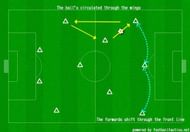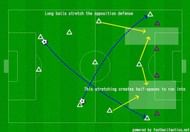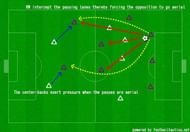Julen Lopetegui's appointment process has been turbulent for Real Madrid. But there is little time for him to ponder on that. Madrid has become quite familiar with the Champions League title but the La Liga has been a nagging problem in recent years. The season-long title demands consistency and this trait would be pretty high up in Lopetegui's to-do list.

With Cristiano Ronaldo moving on from Real Madrid, there is a more than 40 goals-per-season hole to take care of. This also opens up interesting ideas to execute in the offense for the coach.
The shape
Real Madrid played 4-3-3 consistently under Zidane and that continues to be the case under Lopetegui. The offensive build-up is predominantly through the wings with the full-back, mid-fielder and the winger creating triangles to move the ball forward. The attacks become more central in the second half when the tired opponent's legs leave open spaces. Off the ball, players take up positions that try to cut-off the dangerous passes coming from the opposition.
Lopetegui also tried out a 4-2-1-3 occasionally, slotting Isco into that attacking-mid role to add an offensive edge to the team while Kroos and Casemiro screen the defense.
This mid-field role is also used to press aggressively high up the pitch once the lead is registered. Cabellos is instrumental to this. Tracking back when the ball's lost is a necessity in this shape as the gap through the middle can be stretched and Madrid become prone to counters quite often.

Kroos has been a constant in the midfield right from the start of the season while Casemiro, Isco and Cabellos take turns to slot into the midfield. Modric is being eased into the playing eleven after an incredible summer. Most of these players can play multiple roles in the midfield and that might be crucial at maintaining flexibility in the middle of the pitch as the season unfolds.
On the ball
Wing play
Building from the back, Madrid's movement forward happens majorly through the wings - full-backs and wingers drive it forward with the support of the midfielders. Having players with the skill to pull off this strategy, Madrid consistently asks questions of the opposition who possess strong defensive blocks.
The wing play helps to manipulate the opposition’s shape as they attract the press on to one side of the pitch, leaving a couple of players on the other side unmarked. The first goal against Getafe is one such instance where Carvajal was left alone in the box to pounce on the second ball as the defense was busy on the other side of the pitch.
While facing disciplined defensive systems, Madrid chooses the aerial root as Plan-B.
Aerial balls
When the half spaces and the passing lanes are not available to capitalize on, Madrid takes it up a notch and send out cross-field aerial balls across wings. This serves two purposes.
One, these passes stretch the opponent's defence, more effective on wider pitches like Bernabeu, thereby present the forwards with opportunities to run into the half spaces or the vacant wing areas to create dangerous situations. Two, these balls are capable of raising the tempo of the game to accelerate actions and create chances with the forwards taking on the back-4 directly. Kroos efficiently uses these balls to control the speed of the game.
Ramos is particularly impressive at his judgement to send out the long diagonal balls out into the right wing for either Carvajal or Bale to pick and surge ahead.

Game through the middle
As the opposition's legs wear out running behind the ball for an hour and with the Real players at comparatively better energy levels, Madrid start attacking through the middle. Asensio and Bale start attacking the half spaces through the defense and send in the crosses.
Madrid also have players who can come on from the bench and start picking up passes through the midfield, as Modric did against Getafe. Marcelo starts playing with freedom as the opponent's pressure softens. He surges into the midfield adding creativity to that left side.
4-2-1-3 too would give the flexibility to dominate the mid-field possession. Isco slots in the number-10 role and dictates the game more with his passing range through the lines and the runs behind the defender.
Offensive transitions
Madrid's forwards are always on alert. They maintain a consistent press or take positions to cut off passing lanes. They are also smart at reading the opposition players who are hesitant on the ball. They run down aggressively and create mistakes. This diligence led to a goal against Leganes where Asensio tracked a backward throw and the defender succumbed to the pressure and conceded the possession.
Madrid has always been surgical at exploiting the disjointed shape of the opposition as they lose the ball. Then the Real players would counter with purpose and precision. Having Isco on the pitch makes them deadly in these scenarios.
Off the ball
Defensive shape
With higher possession numbers in the games until now, Madrid are yet to defend for long spells. But there was a hint of what's in store.
While defending, the forward players generally take up positions that cut off the passing lanes for the opposition. They are on guard consistently looking out for timid passes and misjudgement from the opposition players.
The midfielders and the centre-backs work together to exhaust any available spaces for the opposition to capitalize on. But, this can leave an opposition player unmarked on the other side of the pitch waiting for an aerial pass. The reliance on the speed and individual abilities of the full-back and centre back to win that duel is evident in these instances. Real are ready to take the risk even if this can potentially mean conceding goals against better oppositions.

Defensive transitions
When the possession's conceded, Madrid players press aggressively to win the ball back. The players from the next line of defense remain alert to cut-off passes to the opposition players stationed in-between lines. This is most effective when the ball is lost on the wings where the opposition has only one side of the pitch to move into. This makes it fairly easier to apply the defensive tactics and increase the chances to win the ball back.
The danger is imminent when the ball is lost in the midfield as the opponent can spread the ball on either side of the pitch, leaving Real guessing while chasing back.
This was evident in the game against Girona where Isco was playing a more attacking role. There was a definite gap between forwards and defenders when the ball was lost in the middle, leaving open spaces for Girona players to utilize and led to a goal. The attacking midfielder tracking back is essential to maintain the balance while playing 4-2-1-3.
Looking forward
Lopetegui is dynamic with his ideas at Real Madrid in the first few weeks. The team looks fresh going forward with the likes of Benzema, Bale and Asensio eager to set their own standard.
The structural flexibility would be a plus as the season unfolds and Isco has never been this important for Madrid.
There will be tougher challenges in the future and the defensive shape would be put through sterner tests. Lopetegui would like to sell the idea of working together as a team defending, just like they are one going forward.
